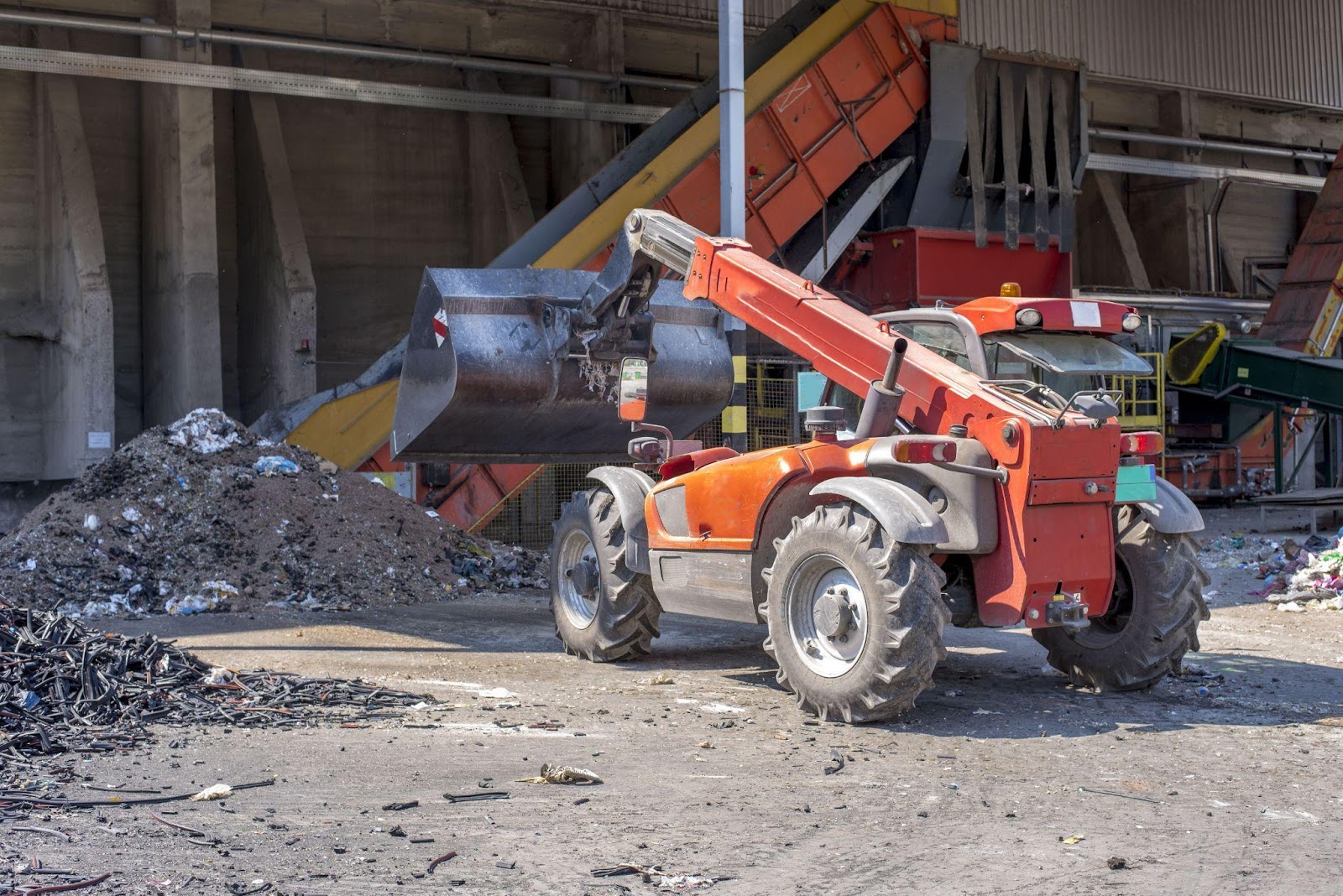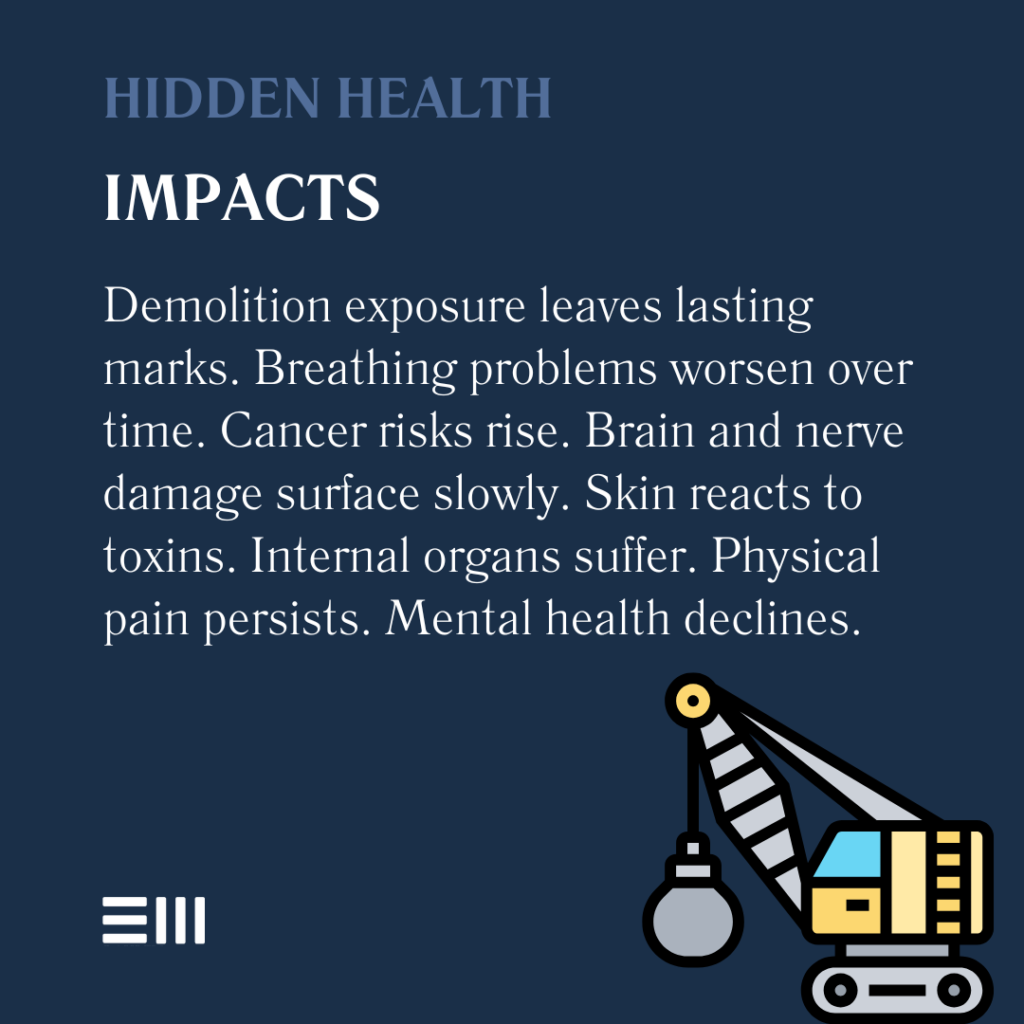
In the blink of an eye, a routine demolition project can transform into a life-altering incident. In demolition, also referred to as extraction work, over 160 out of every 10,000 demolition workers sustain injuries each year while carrying out demolition tasks, according to BLS data.
When century-old buildings come down and hidden hazards emerge, construction workers face some of their most dangerous moments on the job.
Each demolition site tells a story of calculated risks, unseen dangers, and the delicate balance between progress and safety.
For workers and their families, understanding these risks and knowing their rights isn’t just important—it’s a matter of survival.
Understanding Demolition Accidents and Hazardous Materials
Demolition work combines the everyday risks of construction with the unique challenges of dismantling structures while protecting workers from deadly materials like asbestos and lead.
Every phase requires careful planning, proper equipment, and strict adherence to safety protocols to prevent catastrophic failures.
The complexity of modern demolition projects has increased dramatically with the rise of urban redevelopment and the presence of hazardous materials in aging structures.
Common causes of demolition accidents include:
- Unplanned structural collapses during selective demolition;
- Falls from heights during manual demolition work;
- Equipment malfunctions with specialized demolition machinery;
- Electrical hazards from unmarked or live wires;
- Flying debris and falling objects from upper levels;
- Exposure to toxic materials during material removal;
- Fire and explosion risks from hidden combustibles; and
- Improper load-bearing wall removal sequences.
The risks associated with these accidents are often compounded by the presence of various hazardous materials, which include:
- Asbestos in older buildings’ insulation, flooring, and roofing;
- Lead-based paint and materials in pre-1978 structures;
- Silica dust from concrete cutting and breaking;
- PCBs in old electrical equipment and transformers;
- Mercury in switches, thermostats, and fluorescent lights;
- Chemical residues from industrial processes;
- Biological hazards from waste or infestations; and
- Radioactive materials in industrial and medical facilities.
Modern demolition projects increasingly use advanced technologies like remote-controlled equipment and real-time monitoring systems to enhance safety.
However, these innovations bring their own challenges, requiring specialized training and careful integration with traditional methods. Understanding both conventional and emerging risks helps workers and employers maintain safer demolition sites.
Each demolition project presents unique challenges based on the building’s age, construction type, location, and previous use.
Urban demolition requires additional considerations for protecting neighboring structures and pedestrians, while industrial demolition often involves managing complex systems of hazardous materials and utilities.
Understanding these risks and materials is essential for developing effective prevention strategies and response protocols that protect everyone involved in demolition projects.
Safety Regulations and Employer Responsibilities
OSHA mandates specific requirements for demolition work and hazardous material handling, establishing a comprehensive framework for workplace safety.
These regulations evolved from decades of industry experience and tragic accidents that highlighted the need for stricter controls.
Employers must:
- Conduct thorough engineering surveys before starting demolition work;
- Develop and implement comprehensive safety plans for each project phase;
- Provide appropriate personal protective equipment for specific hazards;
- Ensure all workers receive proper training and certification;
- Monitor air quality and exposure levels throughout the project;
- Maintain detailed emergency response protocols;
- Document all safety procedures and incident reports;
- Regularly inspect equipment and maintain safety systems;
- Coordinate with utilities to ensure proper disconnection;
- Implement proper waste disposal procedures;
- Establish clear communication systems; and
- Create detailed site security plans.
Beyond these basic requirements, employers must also:
- Maintain updated safety data sheets for all hazardous materials;
- Provide adequate ventilation and containment systems;
- Establish decontamination procedures;
- Create emergency evacuation routes;
- Install proper signage and barriers;
- Conduct regular safety meetings and updates;
- Maintain first aid and emergency response equipment;
- Document all training and certifications;
- Implement proper material handling procedures; and
- Establish clear chains of command.
These requirements form the foundation of workplace safety in demolition projects, with each element playing a crucial role in preventing accidents and protecting workers.
Regular updates to safety protocols ensure compliance with evolving industry standards and new technological developments.
Worker Rights and Protections
The law provides extensive protections for workers involved in demolition and hazardous material handling.
Understanding these rights is crucial for maintaining workplace safety and ensuring proper compensation in case of accidents.
Every demolition worker has fundamental rights regarding safety:
- Access to appropriate safety equipment and comprehensive training;
- Detailed information about hazardous materials present on site;
- Right to refuse work in unsafe conditions without retaliation;
- Protection from discrimination for reporting safety violations;
- Regular medical monitoring when exposed to toxic substances;
- Complete access to personal exposure records and test results;
- Active representation in safety inspections and planning;
- Confidential reporting of violations to regulatory agencies;
- Participation in workplace safety committees;
- Access to multilingual safety information when necessary;
- Right to stop work in imminent danger situations; and
- Protection under whistleblower statutes.
Additional protections include:
- Right to review safety plans and procedures;
- Access to proper decontamination facilities;
- Regular breaks in extreme conditions;
- Proper respiratory protection programs;
- Coverage under workers’ compensation;
- Right to union representation;
- Access to independent medical evaluations; and
- Protection during regulatory investigations.
Knowledge of these rights empowers workers to maintain safer workplaces and ensures they can take appropriate action when safety standards are compromised.
Understanding and exercising these rights not only protects individual workers but contributes to overall workplace safety culture.
Steps to Take After an Accident
Quick action after a demolition or hazardous material incident protects your health and legal rights:
- Seek immediate medical attention
- Report the incident to supervisors
- Document the accident scene
- Collect witness information
- Preserve protective equipment
- Request copies of incident reports
- Track all medical treatments
- Keep detailed exposure records
- Contact qualified legal counsel
- File necessary workers’ compensation claims
Taking these steps promptly can significantly impact the outcome of your case and your recovery process.

Long-term Health Impacts
Exposure to hazardous materials during demolition can cause:
- Respiratory diseases;
- Various cancers;
- Neurological disorders;
- Skin conditions;
- Organ damage;
- Reproductive issues;
- Chronic pain; and
- Mental health challenges.
Many symptoms appear years after exposure, making documentation crucial for future claims.

Common Questions About Demolition Accidents and Hazardous Materials in Alabama
Understanding your rights and options after a construction accident can feel overwhelming. Here are answers to frequently asked questions:
What Are My Rights if I Was Exposed to Hazardous Materials?
Workers exposed to toxic substances have rights to medical monitoring, workers’ compensation, and potential legal claims against responsible parties beyond their employer.
Who Is Liable for Demolition Accidents?
Multiple parties may share liability:
- Property owners
- General contractors
- Subcontractors
- Equipment manufacturers
- Safety consultants
- Material handlers
Determining liability often requires thorough investigation and legal expertise to identify all responsible parties, as multiple entities typically share responsibility for ensuring safe demolition practices.
Will Workers’ Compensation Cover All My Expenses?
Workers’ compensation typically covers medical bills and partial lost wages but may not address long-term health impacts or full financial losses.
What if My Employer Didn’t Provide Safety Equipment?
OSHA violations can strengthen your case and may allow claims beyond workers’ compensation.
How Can I Prove Hazardous Material Exposure?
Documentation is crucial:
- Medical records
- Workplace exposure logs
- Air quality reports
- Safety violation records
- Witness statements
- Expert assessments
Building a strong case requires comprehensive documentation and expert analysis, making it crucial to begin collecting and preserving evidence as soon as possible after an incident.
Take Action to Protect Your Rights
Demolition accidents and hazardous material exposure can have life-altering consequences.
Our experienced team understands the complexities of construction accident cases and fights to secure the compensation you deserve.
Contact us today for a free consultation and learn how we can help protect your future.
Can't find what you're looking for? Search our site below.










